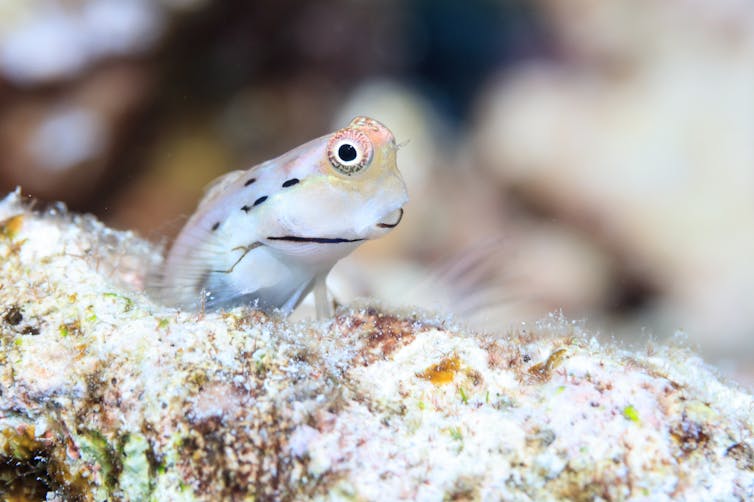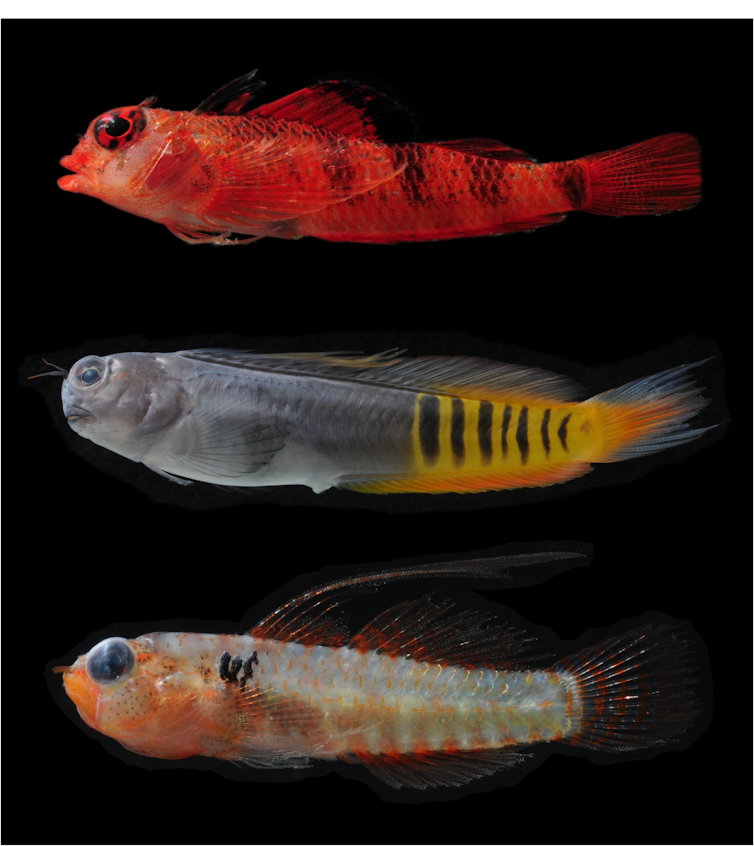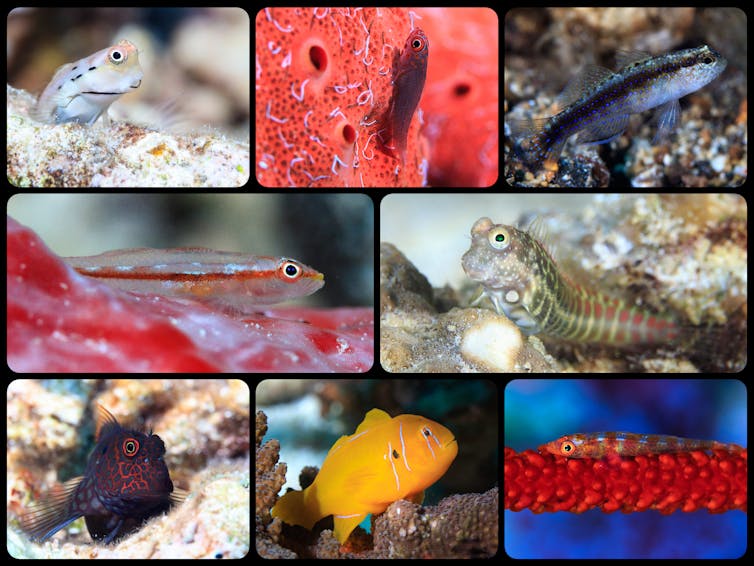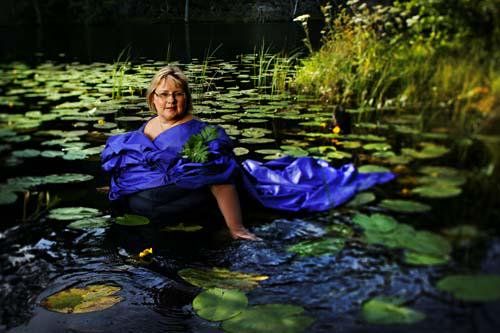
Sinclair-Taylor Tane, Author provided
Simon Brandl, Simon Fraser University and Isabelle Côté, Simon Fraser University
You’re swimming over a coral reef. What do you see? Most people will reply: fish. On a coral reef, fish are large, abundant, gaudily coloured and in-your-face impossible to miss. The waters around coral reefs must be incredibly rich to support such an abundance of life, right? But that is not the case at all. This contradiction is a long-standing ecological puzzle known as Darwin’s paradox.
In the 1830s, Darwin wondered how coral reefs, so bountiful with life, could thrive in areas of the tropical Pacific that were seemingly barren. Although Darwin couldn’t actually measure nutrients in the water, he was right about the apparent barrenness. There are almost no detectable nutrients in the water around coral reefs, which is why it is so clear and blue. It’s quite a contrast with the green soup that characterises the summertime coastal waters of British Columbia or Nova Scotia. There, an abundance of nutrients fuels the growth of small plants, called phytoplankton, at the bottom of the marine food chain.
Clearly, tropical waters around coral reefs must be tapping into some unseen source of energy. Scientists now know that some nutrients do arrive onto coral reefs from nearby land via rock erosion, seabird guano and, increasingly, human activities, to be taken up quickly by phytoplankton that is retained around reefs.
Snack-sized bites
This phenomenon, called the Island Mass Effect, is prevalent near islands and atolls around the world. However, our new study reveals that the breakfast, lunch and dinner plates of reef fishes are also filled by another unlikely and almost universally overlooked source of food that makes these nutrients available: tiny fishes.
Tiny, camouflaged, bottom-dwelling (cryptobenthic) fishes don’t sound like anything to write home about. Anybody casually snorkeling or diving on a reef will see no more of them than brief, barely perceptible flashes of red, white, black, orange, yellow, green or purple as the fish frantically skedaddle to safety among the nooks and crannies of the reef.

Author provided
Tiny fish rarely exceed 50 mm as adults, and most of them are just half this size. They are distributed across 17 families of reef fishes. Some of the more famous ones, like a few species of gobies, blennies and cardinalfishes, make frequent appearances in hobby saltwater aquaria, but the rest (probably up to 4,000 or so) are rarely noticed.
As aficionados of small fish, we are of course biased, but these miniature fishes are absolutely beautiful. They sport all manner of dots, stripes, bars, speckles, blotches and squiggles, in almost all colours of the rainbow. They also have an astounding array of social and reproductive behaviours, ranging from pairing up with shrimps for safety to brooding eggs in their mouths. Some even have the ability to change sex in either direction and back and forth! But because they are outside of the size range that immediately grabs our attention, few people have been interested in these tiny fishes.
Until now…
Small but mighty
How are tiny fish a source of energy for coral reefs? They die. And they do so in droves. These fish will never threaten Methuselah’s longevity record: some never get older than 59 days, because they get eaten so swiftly. So why don’t reefs run out of tiny fish?
The answer lies in the larval stage. Most marine fishes spend their early life — a few days to several weeks — as small larvae in the water column that drift away from where they were spawned. We discovered that about three-quarters of all reef fish larvae near coral reefs are from cryptobenthics, which is an unexpectedly high proportion given the modest reproductive output of tiny fishes. They are able to do this because, instead of having their newly spawned offspring venture into the endless open ocean where food is scarce and predators plentiful, cryptobenthic larvae appear to linger close to the reefs, avoiding the deadly dangers of the open ocean.
Exactly how the tiny fish larvae do this is still a mystery, but it has dramatic consequences for coral reefs. By creating a hyper-abundant reservoir of offspring that can immediately replace each devoured adult, the tiny fish and their rapid turnover account for approximately 60 percent of the fish flesh consumed on reefs, as we reveal in a theoretical population model that tracks the fate of larvae from settlement to death.
In essence, these tiny little fish are like candy in a bottomless jar, placed in the office lunchroom. Everybody will happily grab a handful, but instead of depleting the candy, the jar magically replenishes every time a few pieces of candy are snagged. A near-inexhaustible source of candy fish that are casually devoured by many hungry mouths.

Simon Brandl, Author provided
Reef conservation
Our discovery means that we might have to rethink what the best actions are to conserve coral reefs and their abundant resources in the long term. Right now, the very large fish like sharks or groupers, get most of the attention. Large stretches of coastal ocean, including swathes of coral reefs, have been declared off-limits to fishing to protect these species.
While protection of species targeted by fisheries is important, sharks and all the reef fishes that people like to find on their dinner plates (and, in many places of the world, rely on for their livelihoods), ultimately depend on the tiniest fishes and their mass-production population dynamics. What works in terms of protection for one end of the food chain might not be so useful for the other end. Perhaps it’s time to put our thinking caps on and figure out how to protect the smallest fishy citizens of the reef and the critical service they provide.![]()
Simon Brandl, Postdoctoral research fellow, Simon Fraser University and Isabelle Côté, Professor of Marine Ecology, Simon Fraser University
This article is republished from The Conversation under a Creative Commons license. Read the original article.




19 Comments
Pingback: Candy that looks like fish - Taunt On Water
Pingback: crackling fireplace sound
Pingback: Temporärbüro Zürich
Pingback: judi bola
Pingback: พอตไฟฟ้า
Pingback: lsm99day รวมสล็อตครบวงจร
Pingback: dultogel 777
Pingback: Injectable Steroids For Sale
Pingback: m1a scout
Pingback: aroundtravel
Pingback: Wockhardt Promethazine codeine syrup in
Pingback: กระจกอลูมิเนียม
Pingback: คาสิโนออนไลน์เว็บตรง เว็บแทงบอลอันดับ 1
Pingback: hop over to this website
Pingback: พลาสติกวิศวกรรม
Pingback: เวลาออก เวลาปิดรับ ของ หวยหุ้นดาวโจนส์
Pingback: halo disposable thc vape
Pingback: พนันออนไลน์เว็บตรง เล่นแล้วรวยจริงหรือไม่
Pingback: happyluke